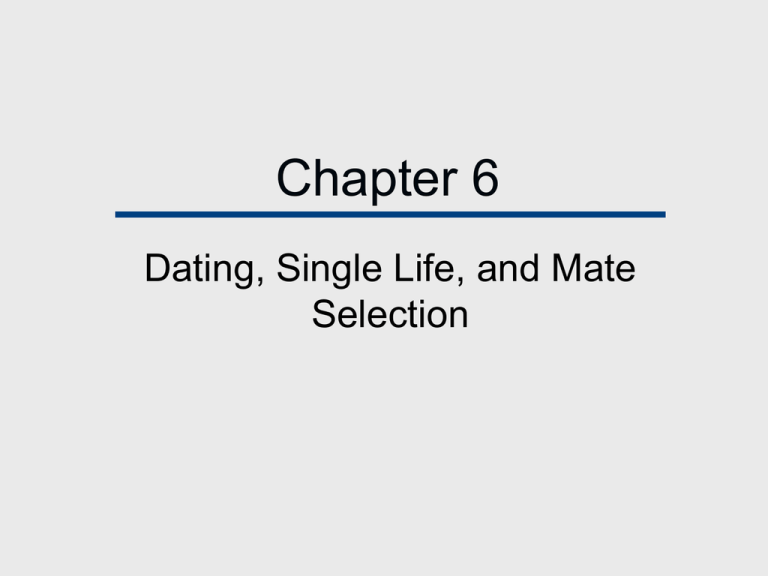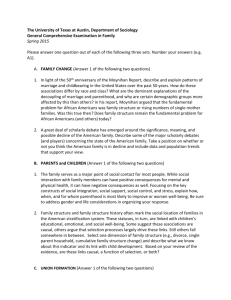
Chapter 6
Dating, Single Life, and Mate
Selection
Chapter Outline
•
Premarital American Dating
•
Dating and Extended Singleness
•
Changing Sexual Mores
•
Date Rape and Courtship Violence
Chapter Outline
•
Cohabitation: Unmarried-Couple
Households
•
Finding the One and Only: Mate
Selection
•
Engagement
Why Do We Date?
1.
2.
3.
Dating fills time between puberty and
marriage. It is often simple recreation, an
end in itself.
Dating is a way to gain social status
based on whom and how often one
dates.
Dating is an opportunity for the sexes to
interact and learn about each other.
Dating is also an avenue to selfknowledge.
Why Do We Date?
4.
Dating meets ego needs. A person
needs to be understood and considered
important.
5.
Dating leads to mate selection for most
individuals.
Modern Dating Characteristics
1.
There is greater opportunity for informal,
opposite-sex interaction.
2.
Subsequent dating is less formal.
3.
There no longer seems to be a set
progression of stages from first meeting
to marriage.
College Dating
•
•
•
Hooking up is defined as a sex-withoutcommitment interaction.
The term joined at the hip refers to couples
who spend much of their time together but
rarely go out on formal dates.
Because of the close proximity of living
conditions in college, there is a great deal of
hanging out, where time is loosely spent
together without explicit interest in one another.
Timing of First Sexual Intercourse
Characteristic
% Distribution
% Who Have
Had Sex
Median Age at
First Sex
Total
100.0
26.6
16.9
Male
53.4
29.7
16.6
Female
46.6
23.3
17.2
Factors Influencing the Decision to
Have Sex
1.
Personal principles
2.
Psychological principles
3.
Social principles
4.
Religious principles
Problems Associated with
Premarital Sexual Relations
•
Sexually transmitted diseases (STDs)
•
Unwanted pregnancies
•
Early commitment and isolation
•
Quality of sex
Date Rape and Courtship
Violence
The term date rape has suddenly
become popular in the mass media. A
better term that encompasses rape but
also speaks to broader problems is
acquaintance violence.
Miscommunication About Sex
1.
Many men and women do not discuss their
sexual intentions openly and frankly.
2.
Differences exist in perceptions of sexual
intent.
3.
The use of token resistance by some women
may create a belief in some men that protest
encountered is not really meant by the woman.
Miscommunication About Sex
4.
There are differing expectations
concerning the stage of the relationship
when sexual intercourse is appropriate.
5.
Miscommunication is more common
when alcohol or drugs are being used.
Statutory Rape
Statutory rape is the case in which
an adult has consensual sex with a
minor.
Cohabitation
A couple’s desire to spend more
time together may lead them to
cohabit, that is, live together without
marriage.
Cohabitation & Common Law
Marriage
•
•
An unmarried partner is now defined by
the Census Bureau as a person unrelated
to the householder, but who shares living
quarters and has a close personal
relationship with the householder.
In some states,a couple living together for
more than a certain number of years can
be treated as legally married, which is
called a common law marriage.
Factors Influencing Cohabitation
•
•
Society’s increased tolerance toward
nonmarital sexual relations makes
intimate cohabitation more acceptable.
Higher education, especially for women,
and the increasing entry of women into
the workforce have lessened women’s
dependence on marriage as a way of
economic survival.
Factors Influencing Cohabitation
•
Increasing urbanization leads to
increased anonymity and fewer
restrictions on individuals.
•
The high rate of divorce may make young
people more wary of rushing into a marital
relationship.
Cohabiting Relationships
•
•
•
•
Many couples consider these experiences to be
no more than short-lived sexual flings.
Other couples consider cohabitation a practical
arrangement.
Some see cohabitation as a trial marriage,
while others see it as a permanent alternative to
marriage.
For some who have been divorced, the fear of
making the same mistake again leads them to
cohabitation.
Mate Selection
•
Propinquity refers to dating and marrying
someone living quite close geographically.
•
Homogamy is the tendency of people to marry
persons similar to themselves.
•
Endogamy is the tendency of people to marry
within their own group.
Mate Selection
•
•
•
Exogamy is a requirement that people
marry outside their group.
In our culture, requirements to marry
outside your group are limited to incest
and same-sex prohibitions.
Miscegenation laws prohibiting
interracial marriages are no longer legal in
the U.S.
First Impressions
The halo effect is the tendency for first
impressions to influence succeeding
evaluations.
Cognitive compatibility (how the other
thinks, what his/ her interests are, and so
on) are also important first impressions.
Quick Quiz
1. The term joined at the hip refers to
a)
b)
c)
d)
a sex-without-commitment interaction.
couples who spend much of their time
together but rarely go out on formal
dates.
where time is loosely spent together
without explicit interest in one another.
None of these.
Answer: b
•
The term joined at the hip refers to
couples who spend much of their time
together but rarely go out on formal dates.
2. The requirement that people marry
outside their group is
a)
Propinquity
b)
Homogamy
c)
Endogamy
d)
Exogamy
Answer: d
•
Exogamy is the requirement that people
marry outside their group.
3. Which of the following is listed in the
text as a common reason for
cohabitation?
a)
b)
c)
d)
Practical Purposes
Sex
Trial Marriage
All of the above
Answer: d
•
Couples studied listed practical purposes,
sex and a chance to have a trial marriage
all as reasons to cohabitate.




